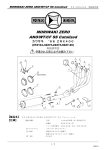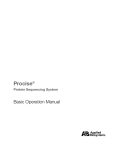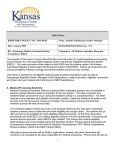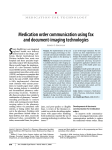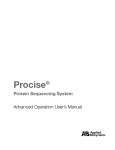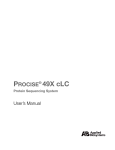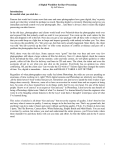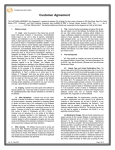Download User Bulletin PROCISE® Protein Sequencing
Transcript
User Bulletin PROCISE® Protein Sequencing System (491/492/494) 1 July 1997 (updated 06/2001) SUBJECT: PROCISE Feature Upgrade Kit Summary This User Bulletin describes the hardware, firmware, and software changes included in the PROCISE® Feature Upgrade Kit (P/N 604463). The new features and the gradient, cycle, procedure, and method changes described in this user bulletin supersede the descriptions found in the PROCISE User’s Manual version A and in the PROCISE Advanced User’s Manual version A. The basic operation of the system remains the same. PROCISE sequencing systems with serial number 451 or higher are manufactured with all components and features of the kit included and do not require the upgrade. Note This User Bulletin does not apply to PROCISE cLC instruments. New Features The PROCISE Feature Upgrade Kit includes the following new features: ♦ New EPROMs for the 140C pump (P/N 604416 and P/N 604417) ♦ New memory card for the PROCISE sequencer (V 1.01, P/N 604256) ♦ Replacement tubing (FEP, P/N 604445) ♦ New chemistry file for the PROCISE sequencer (V 1.1.1, P/N 604475) New EPROMs for the 140C Pump Features The new EPROMs for the Model 140C pump, together with the new memory card for the Procise sequencer, have the following features: ♦ Posting of pump errors ♦ Pump errors pause sequencer ♦ Free Run mode after analysis Posting of Pump Pump errors now appear in the PROCISE Event Log. Errors Pump Errors Pause If the pump is unable to successfully run the required gradient, the sequencer pauses. Sequencer The following pump errors pause the sequencer: ♦ Pump overpressure ♦ Pump underpressure ♦ Valve failure—the solvent switching Rheodyne valve fails to move to the correct position ♦ Pump failure Free Run Mode To improve the consistency of retention times of chromatographic peaks, the new After Analysis EPROMs allow the pumps to automatically go into Free Run mode at the end of a sequencing run. To activate the Free Run Mode: Step Action 1 Press the Run key on the front panel of the Model 140C pump. 2 Press the left arrow key to move the cursor to the “Manual?” field in the lower right-hand corner of the screen. Note 3 The default is “N” for no. Press the Next key to change to “Y”. After you make this change, the pump will continue to run at the flow rate and IMPORTANT solvent composition specified in the last line of the last gradient run. Page 2 of 12 User Bulletin : PROCISE® Protein Sequencing System (491/492/494) New Memory Card for the PROCISE Sequencer V 1.01 Summary The PROCISE sequencer firmware is permanently stored on the new memory (MEL) card. The new MEL card corrects some problems from the previous version and adds some new features. Improvements Made The following improvements have been made and problems corrected: and Problems ♦ Intermittent failure of the injector Rheodyne to actuate is eliminated. Corrected ♦ Incorrect position of the Rheodyne injector valve is correctly reported to the Event Log. ♦ Automatic argon flush of HPLC solvents has been eliminated. ♦ Pump errors are reported to the Event Log and will pause the sequencer. ♦ Reagent, solvent, and gas delivery pressures can be adjusted during user-created cycles. Adjusting Delivery To adjust delivery pressure during a user-created cycle: Pressures Step 1 Action Select the cycle you want to modify. Locked cycles must be renamed. Choose Save Cycle/Procedure As… in Note the File menu, and then click OK. 2 Select the step in the program after which the pressure change should occur. 3 Select the function number box, then type 303. The Select Regulator function is highlighted. 4 Click Insert Row to insert this function. 5 Select the Num. Value box and type the number of the regulator (1–10) to be adjusted. All deliveries controlled by the regulator selected (e.g., regulator IMPORTANT 4 controls the deliveries of S1, S2 and S3) are made at the modified pressure until the setpoint is adjusted again. 6 Select the function number box, then type 305. The Set Regulator Setpoint (10th psi) function is highlighted. 7 Click Insert Row to insert this function. 8 Select the Num. Value box and type the new regulator setpoint in 10ths of a psi, e.g., type 15 to set the regulator to 1.5 psi. 9 Repeat steps 2–7 for each pressure adjustment. 10 When all modifications are complete, select Save from the File menu. New Error Message A new error message is now reported to the Event Log. If a sensor detects fluid immediately at the start of a delivery function, it is reported as error “Unknown 89” to the Event Log. This message is for informational purposes only; the sequencer does not pause for this error. The current PROCISE software does not report which sensor detected fluid immediately at the start of the delivery function. If this error message is User Bulletin : PROCISE® Protein Sequencing System (491/492/494) Page 3 of 12 observed frequently, it may indicate a flow restriction through a particular instrument pathway. Page 4 of 12 User Bulletin : PROCISE® Protein Sequencing System (491/492/494) Replacement Tubing (FEP) Problem An artifact peak which co-elutes with PTH-Gln in the PTH-AA chromatogram has been observed on a number of PROCISE sequencers. This peak is largest at the start of a sequencing run (usually decreasing in subsequent cycles) and increases proportionally with the length of time the instrument, or a particular cartridge, has been idle. Cause This chemical artifact has been identified as acetanilide. Acetanilide is formed by the reaction of aniline, a hydrolysis product of phenylisothiocyanate (PITC) and ethyl acetate in the presence of trifluoroacetic acid (TFA). The fluoropolymer tubing (PTFE) used to interconnect the cartridges and the valve blocks was contributing to this problem because it is relatively porous, allowing chemicals to be retained on the tubing surface. Solution The PTFE tubing is being replaced with an alternative type of fluoropolymer tubing (FEP), which is much less porous. The reduced porosity of the tubing reduces the accumulation of acetanilide. The following tubing is included in the upgrade kit: ♦ inlet and outlet tubing for the cartridge(s) ♦ tubing that interconnects the valve blocks that supply the reaction cartridge(s) with gas or reagent (four pieces) The new tubing, together with the cycle and method changes included in the new chemistry file, minimize the formation of acetanilide. User Bulletin : PROCISE® Protein Sequencing System (491/492/494) Page 5 of 12 New Chemistry File for the PROCISE Sequencer V1.1.1 Summary A number of changes have been made to the PROCISE chemistry file to improve the performance of the sequencer and to reduce the chemical background due to sequencing. New Functions The following table lists the new functions. Function Number Function Name Purpose 103 Wash Reagent Block (S1) Washes the Cart Reagent Block with the solvent in the S1 bottle position. Used in “Cart, Vlv Blk Wash - S1” cleanup procedure. 104 Wash Solvent Block (S1) Washes the Cart Solvent Block with the solvent in the S1 bottle position. Used in “Cart, Vlv Blk Wash - S1” cleanup procedure. 248 HPLC Solvent Flush Purges the HPLC solvent bottles with argon. 249 Inject Pos/Collect Data Switches the injector Rheodyne valve to the inject position, starts data collection. 250 Start Grad/No Data Coll Starts the default gradient on the HPLC (pumps must be running and counting down to inject). Does not start data collection. New Default The following table shows how the gradient “Fast Normal 1” was updated to reflect the Gradient most recent developments. Time (min) %B Flow Rate (µL/min) 0.0 6 325 0.3 6 325 0.4 16 325 18.0 48 325 18.5 90 325 21.5 90 325 22.0 50 10 continued on next page Page 6 of 12 User Bulletin : PROCISE® Protein Sequencing System (491/492/494) Cartridge Cycle The following changes have been made to the Cartridge Cycles: Changes Change Purpose Additional washing with butyl chloride (S3) Reduces the formation of acetanilide by minimizing the contact of ethyl acetate and TFA in the sequencer. One bottle of S3 now lasts approximately 125–150 cycles. All sequencing cycles include three ATZ extractions, first with S3, then with S2, and finally with S3. Minimizes the contact of ethyl acetate and TFA. Between coupling steps, the cartridge is argon dried from the bottom instead of from the top. Prevents condensate formed in the cartridge inlet line during coupling from being blown onto the sample support. Increased cartridge drying after extraction. Minimizes the amount of residual TFA in the system. The R2 delivery to the cartridge after the extraction was removed. The acid-catalized formation of acetanilide is more effectively reduced by the chemistry and hardware changes noted in this user bulletin, with no potential to compromise the repetitive yield. A global wait step was added to the pulsed-liquid cycles at the end of the cleavage section. Simplifies running an extended cleavage. Using the default global time setting of zero, the cleavage time is 5 min, identical to chemistry file V 1.1. Extending Cleavage To extend the cleavage time in the pulsed-liquid cycles: Time Step Action 1 When the instrument is idle, select Function 257, Wait, from the Functions menu. 2 Highlight the Global Value box and type the amount of time (in seconds) to be added to the cleavage, e.g., to increase the length of cleavage to 6 minutes, type 60 in the Global Value field Note 3 By default, 300 sec are included from the standard cycles. From the File pull-down menu at the top of the screen, select Save Function to save the Global Value. All blot cycles are modified and renamed. The Cart Pulsed-liquid Blot cycle is now called Cart PL PVDF Protein. This cycle is intended for use with electroblotted or ProSorb™-prepared protein samples and includes a delivery of 50% methanol from the X1 bottle before the coupling to improve coupling efficiency. The Cart PL PVDF Peptide cycle is intended for ProSorb- or MicroBlotter™-prepared peptide samples for which polybrene will be applied, and does not include the X1 delivery. Similarly, the Cart Gas-phase Blot cycle is now called Cart GP PVDF Protein, and Cart GP PVDF Peptide has been added. continued on next page User Bulletin : PROCISE® Protein Sequencing System (491/492/494) Page 7 of 12 New Cartridge ♦ Cycles ♦ Flask Optimize - Cart The Flask Optimize - Cart cycle mimics the extraction and transfer steps in a normal cartridge cycle to allow optimization of the flask dry times Cart PL Proline The Cart PL Proline cycle can be used to improve the efficiency of cleavage of proline residues. This cycle uses a higher cleavage temperature (53 °C vs. 48 °C in the standard cycles) to reduce the amount of lag observed after a proline residue. To use this cycle, add it to a pulsed-liquid method as an exception cycle. The number of the exception cycle should be the position of the proline(s) in the sequence plus three, to account for the prep pump, blank and standard cycles. For example, if the proline is at residue seven, add the proline cycle as cycle ten. Flask Cycle Changes ♦ ♦ New Flask Cycles ♦ All flask cycles have approximately 90 sec added to the time allotted for column equilibration before the sample injection. The Flask Normal Blot cycle was deleted because all cartridge cycles now use three extractions, S3, S2, and then S3. Injector Optimize cycle This cycle is used in the Inject Optimize method to optimize the length of the Concentrate Sample step. ♦ Manual Injection cycle This cycle is used in the Manual Injection method to start the HPLC pump and perform a manual injection. ♦ Flask Optimize - Flask cycle This cycle is used in the Flask Optimize method together with the Flask Optimize Cart cycle to optimize the Pre-conversion and Post-conversion dry times. New Cleanup Cart, Vlv Blk Wash - S1 Procedure This procedure washes through the reaction cartridges and all the associated valve blocks with the solvent in the S1 bottle. Methanol is the recommended solvent. (The S1 bottle is not used in the standard PROCISE-HT chemistry cycles.) Leak Procedure Cartridge Leak Test Changes The leak test for the cartridges has been shortened to less than 2 min per cartridge. In addition, the leak specification has been adjusted slightly to compensate for the fact that the leak test is performed without heating the cartridge. continued on next page Page 8 of 12 User Bulletin : PROCISE® Protein Sequencing System (491/492/494) Method Changes ♦ PL PVDF Protein method This method, formerly called the Pulsed-liquid Blot method, is intended for electroblotted- or ProSorb-prepared protein samples and includes a delivery of 50% methanol from the X1 bottle before the coupling to improve coupling efficiency. ♦ PL PVDF Peptide method This is a new pulsed-liquid blot method. This method is intended for ProSorb- or MicroBlotter-prepared peptide samples to which polybrene will be applied. The X1 delivery is not included; application of polybrene to the membrane eliminates the need for the X1 delivery. ♦ GP PVDF Protein method This method, formerly called the Gas-phase Blot method, is intended for electroblotted- or ProSorb-prepared protein samples and includes a delivery of 50% methanol from the X1 bottle before the coupling to improve coupling efficiency. ♦ GP PVDF Peptide method This is a new gas phase method. This method is intended for ProSorb- or MicroBlotter-prepared peptide samples to which polybrene will be applied. The X1 delivery is not included; application of polybrene to the membrane eliminates the need for the X1 delivery. New Methods ♦ Flask Optimize This method mimics the extraction and transfer steps in a normal cartridge cycle, together with the appropriate flask steps to optimize the preconversion and postconversion dry times. ♦ Injector Optimize This method is used to optimize the length of the Concentrate Sample step. ♦ Manual Injection This method is used to start the HPLC pump and perform a manual injection. User Bulletin : PROCISE® Protein Sequencing System (491/492/494) Page 9 of 12 © Copyright 2001, Applied Biosystems For Research Use Only. Not for use in diagnostic procedures. Applied Biosystems and PROCISE are registered trademarks of Applera Corporation or its subsidiaries in the U.S. and certain other countries. ABI, ProSorb and MicroBlotter are trademarks of Applera Corporation or its subsidiaries in the U.S. and certain other countries. All other trademarks are the sole property of their respective owners. 905018B Stock Number 347845-002












